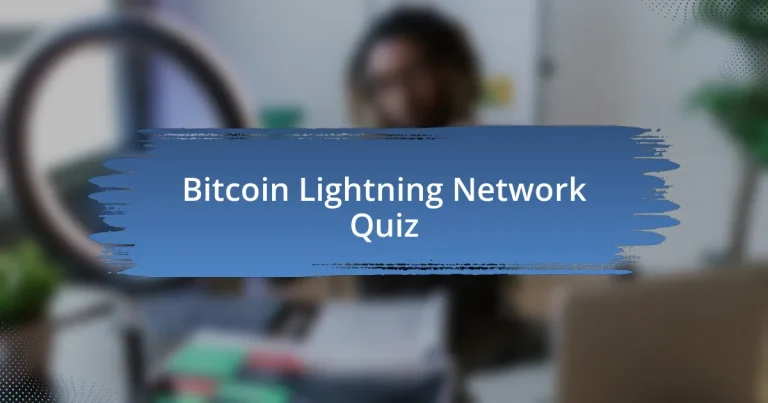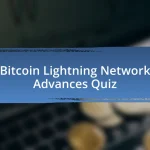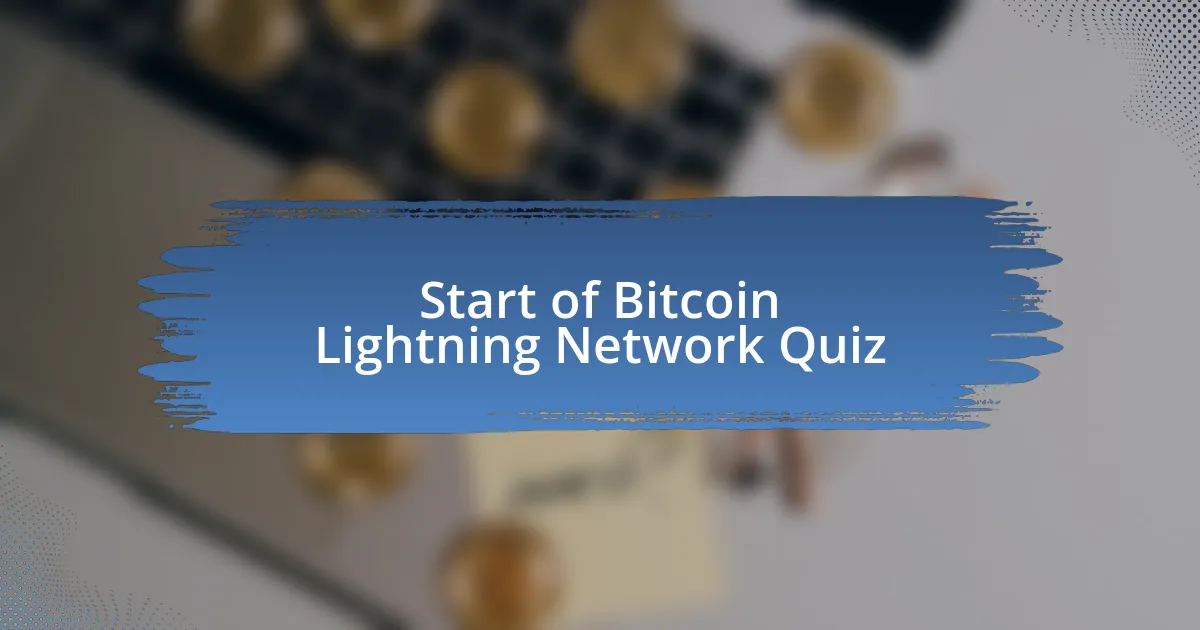
Start of Bitcoin Lightning Network Quiz
1. What is the primary function of the Bitcoin Lightning Network?
- To solve the scalability problem of the Bitcoin network by adding an extra layer for faster and more efficient transactions.
- To provide a platform for launching new cryptocurrencies.
- To enable anonymous transactions that bypass all regulations.
- To eliminate the need for blockchain technology altogether.
2. How does the Lightning Network address scalability issues?
- By increasing the block size limit to accommodate more transactions at once.
- By requiring all nodes to validate every transaction for security.
- By processing all transactions directly on the blockchain to ensure transparency.
- By allowing users to set up payment channels, enabling thousands of small and medium-sized transactions to take place off the main blockchain.
3. What are micropayments in the context of the Lightning Network?
- Large transactions processed on the main blockchain.
- Only transactions involving multiple currencies at once.
- Small transactions that occur within a payment channel, typically happening instantly.
- Payments that are delayed for verification by multiple nodes.
4. How are payment channels established in the Lightning Network?
- By transferring bitcoins directly to another user`s wallet without any prior setup.
- By creating a multi-signature wallet and recording the initial creation and final settlement of the channel on the Bitcoin blockchain.
- By issuing tokens on a centralized exchange for trading purposes.
- By requiring each transaction to be approved by all network nodes in real-time.
5. What is an anchor transaction in the Lightning Network?
- A transaction that closes an existing payment channel.
- A transaction that routes payments between multiple users.
- A frequent payment made within the network without blockchain confirmation.
- The initial transaction recorded on the Bitcoin blockchain to establish a payment channel.
6. What happens at the end of a payment channel?
- The channel remains open indefinitely without any finalization.
- All transactions are deleted permanently without being recorded.
- The final balance of the channel is sent to the network, processed, and added to the main blockchain.
- Funds are transferred to a central server for processing and approval.
7. What are timelocks in the context of the Lightning Network?
- A feature that guarantees instant fund transfers without any fees.
- A mechanism to set an upper limit on how long a payment channel remains open, preventing one user from locking funds indefinitely.
- A type of smart contract that allows users to create unlimited channels.
- A system to ensure all transactions are recorded on the main blockchain without delay.
8. What are asymmetric revocation commitments in the Lightning Network?
- A strategy to double the amount of Bitcoin in each transaction automatically.
- A technique that allows users to trade assets directly on the main blockchain.
- A way to punish users who try to cheat the system by allowing the cheated user to claim the full balance of a wallet, leaving the cheater with nothing.
- A method for increasing transaction fees paid by users for faster service.
9. How fast are transactions typically processed in the Lightning Network?
- Every few minutes.
- Almost instantaneously.
- Only during peak hours.
- Within a few hours.
10. What is the throughput of the Bitcoin Layer-2 Lightning Network?
- Up to 1 million transactions per second (TPS).
- Up to 100,000 transactions per second (TPS).
- Up to 500,000 transactions per second (TPS).
- Up to 10 million transactions per second (TPS).
11. How does the Lightning Network handle transactions between parties without a direct channel?
- By directly confirming transactions on the main blockchain.
- By routing payments through interconnected channels.
- By limiting payments to only direct channels.
- By only allowing transactions between the same parties.
12. What is the primary benefit of using the Lightning Network for transactions?
- Higher transaction fees for every payment.
- Mandatory disclosure of all transaction details.
- Increased speed and privacy of transactions.
- Limited to large transactions only.
13. What is the default TCP port used for the Bitcoin mainnet in the Lightning Network?
- Port number 8080
- Port number 3000
- Port number 9735
- Port number 4433
14. What is the Unicode code point for LIGHTNING in the context of the Lightning Network?
- U+26A1
- U+1F329
- U+1F4A5
- U+274C
15. What is the format of a Lightning message after decryption?
- `type`: a 2-byte big-endian field indicating the type of message, `payload`: a variable-length payload, and `extension`: an optional TLV stream.
- `version`: a 1-byte protocol version, `content`: a serialized transaction list, and `signature`: a cryptographic signature for validation.
- `length`: a 4-byte little-endian field defining the total size, `data`: a fixed-length data field, and `checksum`: a final validation code.
- `header`: a 3-byte network identifier, `body`: structured data for transactions, and `footer`: a mandatory end sequence.
16. What are the five logical groups of messages in the Lightning Network?
- Create & Destroy (types `0`-`31`), Node (types `32`-`127`), and two other groups.
- Setup & Control (types `0`-`31`), Channel (types `32`-`127`), and three other groups.
- Input & Output (types `0`-`31`), Transaction (types `32`-`127`), and five other groups.
- Fund & Withdraw (types `0`-`31`), Payment (types `32`-`127`), and four other groups.
17. What is BOLT #1 in the context of the Lightning Network?
- BOLT #1 is a protocol for implementing traditional banking systems within Bitcoin.
- BOLT #1 provides guidelines for Bitcoin`s public ledger management.
- BOLT #1 outlines the rules for creating Bitcoin mining pools.
- BOLT #1 assumes an underlying authenticated and ordered transport mechanism for framing individual messages.
18. What is BOLT #8 in the context of the Lightning Network?
- BOLT #8 describes the process for closing payment channels in the Lightning Network.
- BOLT #8 outlines the method for user authentication in the Lightning Network.
- BOLT #8 specifies the canonical transport layer used in the Lightning Network.
- BOLT #8 regulates the fees associated with transactions on the Lightning Network.
19. What are the common networks used in the Lightning Network?
- Ripple mainnet, Ripple testnet, and Ripple signet.
- Ethereum mainnet, Ethereum testnet, and Ethereum signet.
- Litecoin mainnet, Litecoin testnet, and Litecoin signet.
- Bitcoin mainnet, Bitcoin testnet, and Bitcoin signet.
20. What are the default TCP port numbers for Bitcoin testnet and Bitcoin signet?
- Bitcoin testnet uses port number 12345, and Bitcoin signet uses port number 54321.
- Bitcoin testnet uses port number 8080, and Bitcoin signet uses port number 9090.
- Bitcoin testnet uses port number 19735, and Bitcoin signet uses port number 39735.
- Bitcoin testnet uses port number 9000, and Bitcoin signet uses port number 7000.
21. What is the primary benefit of using payment channels in the Lightning Network?
- Allowing users to send an unlimited number of virtually instant and inexpensive transactions.
- Allowing only large-scale transactions on the main blockchain.
- Reducing the total supply of Bitcoin over time.
- Making all transactions completely anonymous.
22. How do users lock Bitcoin to establish a payment channel?
- By transferring Bitcoin directly to a centralized exchange.
- By locking a certain quantity of Bitcoin onto the network.
- By sending Bitcoin to a private wallet untracked by the chain.
- By making multiple small payments to different addresses.
23. What happens if a customer wishes to keep a payment channel open?
- They must always close the channel after each transaction.
- They may choose to continuously add Bitcoin to the channel.
- They will automatically lose their balance if they keep it open.
- They cannot make any more transactions until the channel is closed.
24. How do transactions on the Bitcoin blockchain differ from standard transactions in the context of the Lightning Network?
- All transactions are processed on the blockchain instantly without exceptions.
- All transactions in the Lightning Network need to be recorded on the Bitcoin blockchain every time.
- Transactions in the Lightning Network require manual approval from all nodes before processing.
- Some transactions, like opening and closing channels, are managed differently and only update the primary blockchain.
25. What happens without notifying the main blockchain during transactions in the Lightning Network?
- The funds are frozen until the main blockchain is updated.
- The two parties can exchange funds indefinitely without updating the main blockchain.
- The transaction fails and no funds are exchanged.
- The transaction is recorded on the main blockchain immediately.
26. How does the Lightning Network accelerate transactions?
- By processing all transactions directly on the main blockchain.
- By eliminating the need for Bitcoin entirely in transactions.
- By not requiring approval from all nodes for each transaction, significantly accelerating the process.
- By using a centralized server to manage all transactions.
27. What is the result of combining individual payment conduits between parties in the Lightning Network?
- The elimination of all transaction fees.
- The introduction of a central authority for payments.
- The establishment of permanent payment channels.
- The creation of nodes with the ability to route transactions.
28. What is the proposed implementation of the Lightning Network?
- Centralized transaction processing through single servers.
- Peer-to-peer transactions without any contract.
- Hashed Timelock Contracts (HTLCs) with bi-directional payment channels.
- A fixed transaction fee for every payment made.
29. What allows payments to be securely routed across multiple peer-to-peer payment channels in the Lightning Network?
- Multi-Signature Wallets
- Payment Requests
- Interconnected Nodes
- Hashed Timelock Contracts (HTLCs)
30. How many channels were there as of March 2019, carrying more than 764 bitcoins?
- Exactly 10,000 channels.
- Less than 1,000 channels.
- More than 37,000 channels.
- About 1,500 channels.
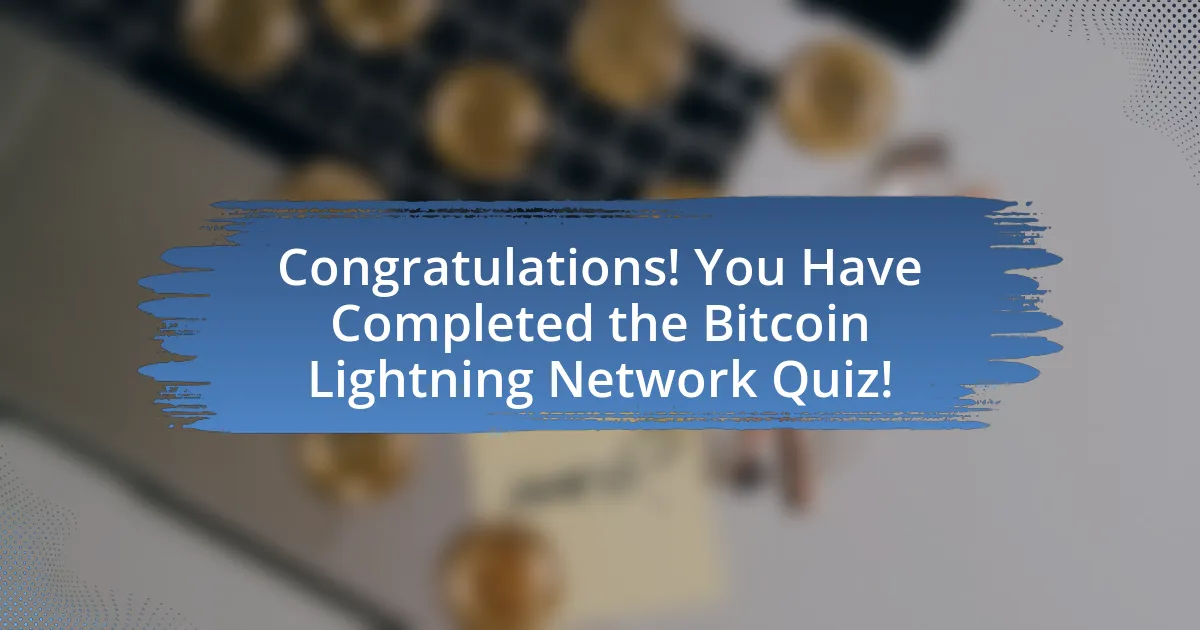
Congratulations! You Have Completed the Bitcoin Lightning Network Quiz!
Well done on finishing the quiz about the Bitcoin Lightning Network! You’ve explored key concepts such as how the Lightning Network enhances transaction speed and reduces fees. Understanding these elements is crucial in grasping why this technology is pivotal for the future of Bitcoin.
Throughout the quiz, you learned about the technical workings of payment channels and the benefits they offer. You also delved into real-world applications and scenarios where the Lightning Network shines. These insights enhance your overall understanding of cryptocurrency as a whole.
If you’re eager to dive deeper into this topic, we invite you to check out the next section on this page. It offers detailed information that expands on what you’ve just learned. Continue your journey into the fascinating world of the Bitcoin Lightning Network!
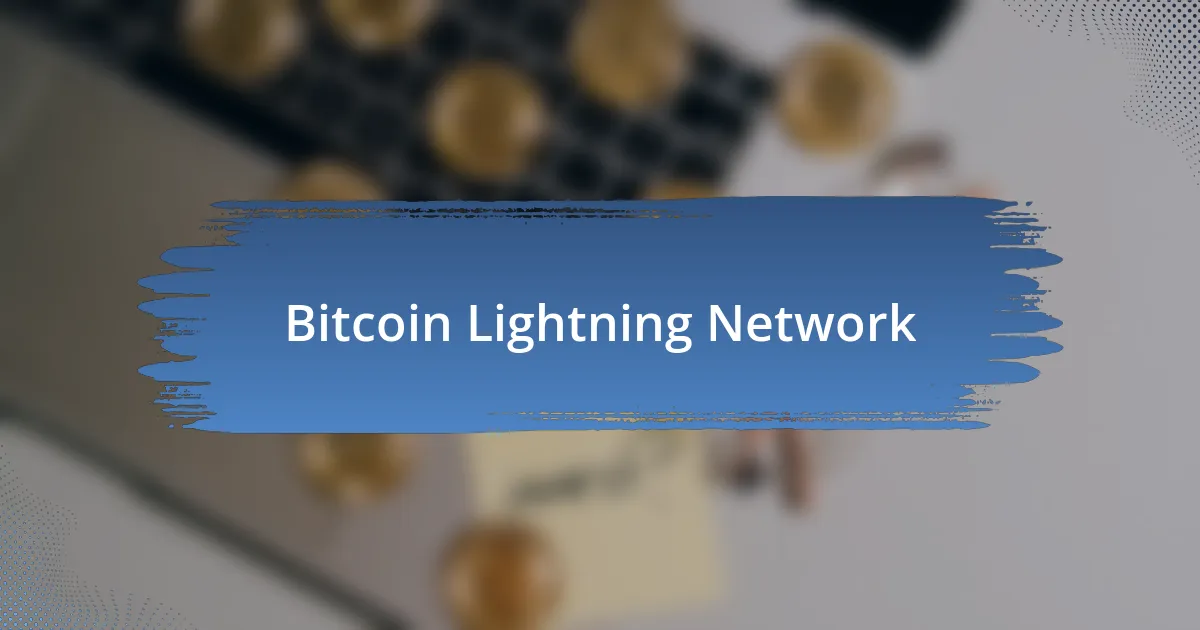
Bitcoin Lightning Network
Overview of the Bitcoin Lightning Network
The Bitcoin Lightning Network is a second-layer solution designed to facilitate faster and cheaper transactions on the Bitcoin blockchain. It operates by creating off-chain payment channels between users, allowing them to conduct transactions without recording every single one on the main blockchain. This approach significantly reduces network congestion and fees while enabling microtransactions. The Lightning Network utilizes smart contracts and multi-signature wallets to ensure the security of transactions, allowing users to transact instantly while preserving the benefits of the underlying Bitcoin technology.
Key Features of the Lightning Network
Key features of the Bitcoin Lightning Network include instant payments, lower transaction fees, and scalability. Instant payments occur because transactions are not immediately recorded on the blockchain; instead, they are settled off-chain. Lower fees result from reduced congestion on the main blockchain. Scalability is achieved by allowing numerous transactions to be processed simultaneously across different channels, thus increasing the overall transaction throughput of the Bitcoin network. These features address significant limitations associated with the standard Bitcoin transaction model.
Functioning Mechanism of Payment Channels
The Lightning Network operates through payment channels, which are established between two parties who commit some Bitcoin to a multi-signature wallet. Each transaction updates the balance of funds in the channel without broadcasting it to the entire network. Both parties can transact as often as needed until they choose to close the channel. At this point, the final balance is recorded on the Bitcoin blockchain. This process allows for reduced confirmation times and minimizes the load on the network while providing privacy regarding individual transactions.
Use Cases of the Lightning Network
The Lightning Network supports various use cases, including microtransactions, merchant payments, and content monetization. Microtransactions benefit from the low fees and quick processing times, enabling users to pay for small amounts of digital goods or services. Merchants can use the Lightning Network to accept payments instantly, enhancing customer experience. Additionally, content creators can monetize their work through tip-based systems or pay-per-view models, leveraging the efficiency of the Lightning Network.
Challenges and Limitations of the Lightning Network
Despite its benefits, the Bitcoin Lightning Network faces challenges and limitations. These include liquidity concerns, as users must lock up funds in payment channels, which can limit transaction volume. Additionally, the network’s complexity can be a barrier for new users. Channel management may require technical knowledge, leading to potential user errors. Finally, as the network grows, ensuring sufficient routing and liquidity across channels remains a challenge to avoid bottlenecks in transaction processing.
What is the Bitcoin Lightning Network?
The Bitcoin Lightning Network is a second-layer scaling solution designed to facilitate faster and cheaper transactions on the Bitcoin network. It allows users to create off-chain payment channels that can process multiple transactions without needing to record each one on the main blockchain immediately. This innovation increases transaction throughput and reduces fees, making it viable for frequent small transactions. The network leverages payment channels to enable rapid micropayments, addressing Bitcoin’s scalability issues.
How does the Bitcoin Lightning Network work?
The Bitcoin Lightning Network works by creating payment channels between users. These channels are established off-chain, allowing parties to transact without broadcasting each transaction to the Bitcoin blockchain. The initial funding transaction opens the channel, and subsequent transactions can occur almost instantly between the two parties. Once the channel is closed, the final balance is recorded on the blockchain. This mechanism significantly reduces congestion on the main blockchain and lowers transaction fees.
Where can I use the Bitcoin Lightning Network?
You can use the Bitcoin Lightning Network at various merchants and platforms that support it, including online retailers, gaming sites, and payment processors. Many wallet applications also integrate Lightning Network functionality, allowing users to send and receive payments easily. Notable services include Bitrefill, Fold, and Lightning Pizza, which let users pay directly with Bitcoin over the Lightning Network for immediate transactions.
When was the Bitcoin Lightning Network launched?
The Bitcoin Lightning Network was launched in January 2016. The initial development was driven by Joseph Poon and Thaddeus Dryja, who published a whitepaper outlining the protocol. Following its introduction, various implementations and improvements have been made, leading to increased adoption and integration with wallets and payment services over time.
Who developed the Bitcoin Lightning Network?
The Bitcoin Lightning Network was co-developed by Joseph Poon and Thaddeus Dryja. They released a whitepaper titled “The Bitcoin Lightning Network” in 2016, outlining the conceptual framework for this scaling solution. Since then, many developers and companies have contributed to its implementation, creating various software and tools to facilitate its use.
